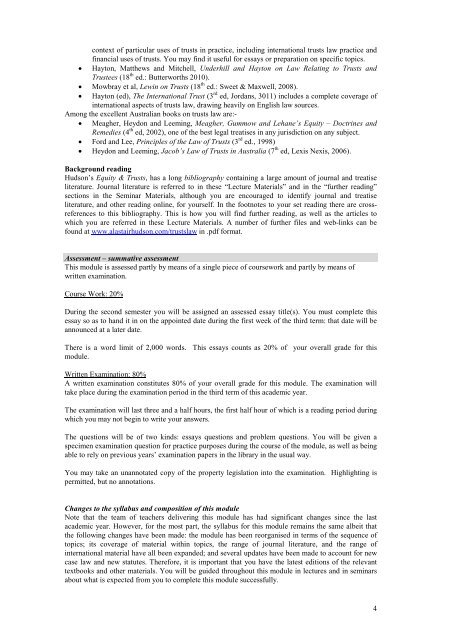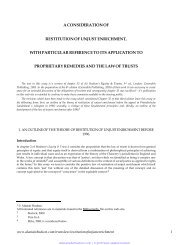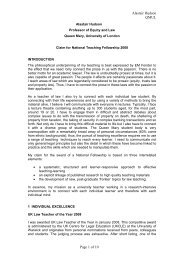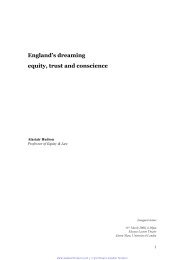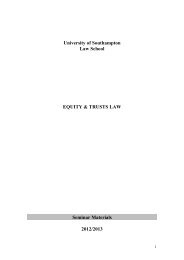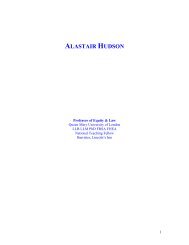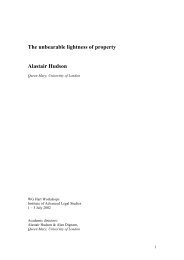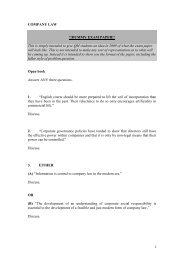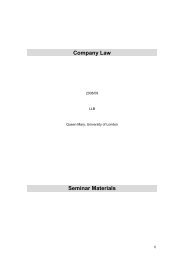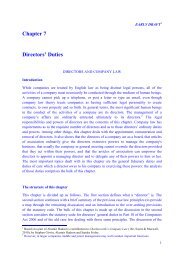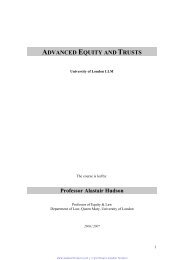Soton Equity and Trusts - alastairhudson.com
Soton Equity and Trusts - alastairhudson.com
Soton Equity and Trusts - alastairhudson.com
Create successful ePaper yourself
Turn your PDF publications into a flip-book with our unique Google optimized e-Paper software.
context of particular uses of trusts in practice, including international trusts law practice <strong>and</strong><br />
financial uses of trusts. You may find it useful for essays or preparation on specific topics.<br />
Hayton, Matthews <strong>and</strong> Mitchell, Underhill <strong>and</strong> Hayton on Law Relating to <strong>Trusts</strong> <strong>and</strong><br />
Trustees (18 th ed.: Butterworths 2010).<br />
Mowbray et al, Lewin on <strong>Trusts</strong> (18 th ed.: Sweet & Maxwell, 2008).<br />
Hayton (ed), The International Trust (3 rd ed, Jordans, 3011) includes a <strong>com</strong>plete coverage of<br />
international aspects of trusts law, drawing heavily on English law sources.<br />
Among the excellent Australian books on trusts law are:-<br />
Meagher, Heydon <strong>and</strong> Leeming, Meagher, Gummow <strong>and</strong> Lehane’s <strong>Equity</strong> – Doctrines <strong>and</strong><br />
Remedies (4 th ed, 2002), one of the best legal treatises in any jurisdiction on any subject.<br />
Ford <strong>and</strong> Lee, Principles of the Law of <strong>Trusts</strong> (3 rd ed., 1998)<br />
Heydon <strong>and</strong> Leeming, Jacob’s Law of <strong>Trusts</strong> in Australia (7 th ed, Lexis Nexis, 2006).<br />
Background reading<br />
Hudson’s <strong>Equity</strong> & <strong>Trusts</strong>, has a long bibliography containing a large amount of journal <strong>and</strong> treatise<br />
literature. Journal literature is referred to in these “Lecture Materials” <strong>and</strong> in the “further reading”<br />
sections in the Seminar Materials, although you are encouraged to identify journal <strong>and</strong> treatise<br />
literature, <strong>and</strong> other reading online, for yourself. In the footnotes to your set reading there are crossreferences<br />
to this bibliography. This is how you will find further reading, as well as the articles to<br />
which you are referred in these Lecture Materials. A number of further files <strong>and</strong> web-links can be<br />
found at www.<strong>alastairhudson</strong>.<strong>com</strong>/trustslaw in .pdf format.<br />
Assessment – summative assessment<br />
This module is assessed partly by means of a single piece of coursework <strong>and</strong> partly by means of<br />
written examination.<br />
Course Work: 20%<br />
During the second semester you will be assigned an assessed essay title(s). You must <strong>com</strong>plete this<br />
essay so as to h<strong>and</strong> it in on the appointed date during the first week of the third term: that date will be<br />
announced at a later date.<br />
There is a word limit of 2,000 words. This essays counts as 20% of your overall grade for this<br />
module.<br />
Written Examination: 80%<br />
A written examination constitutes 80% of your overall grade for this module. The examination will<br />
take place during the examination period in the third term of this academic year.<br />
The examination will last three <strong>and</strong> a half hours, the first half hour of which is a reading period during<br />
which you may not begin to write your answers.<br />
The questions will be of two kinds: essays questions <strong>and</strong> problem questions. You will be given a<br />
specimen examination question for practice purposes during the course of the module, as well as being<br />
able to rely on previous years’ examination papers in the library in the usual way.<br />
You may take an unannotated copy of the property legislation into the examination. Highlighting is<br />
permitted, but no annotations.<br />
Changes to the syllabus <strong>and</strong> <strong>com</strong>position of this module<br />
Note that the team of teachers delivering this module has had significant changes since the last<br />
academic year. However, for the most part, the syllabus for this module remains the same albeit that<br />
the following changes have been made: the module has been reorganised in terms of the sequence of<br />
topics; its coverage of material within topics, the range of journal literature, <strong>and</strong> the range of<br />
international material have all been exp<strong>and</strong>ed; <strong>and</strong> several updates have been made to account for new<br />
case law <strong>and</strong> new statutes. Therefore, it is important that you have the latest editions of the relevant<br />
textbooks <strong>and</strong> other materials. You will be guided throughout this module in lectures <strong>and</strong> in seminars<br />
about what is expected from you to <strong>com</strong>plete this module successfully.<br />
4


